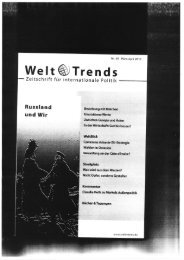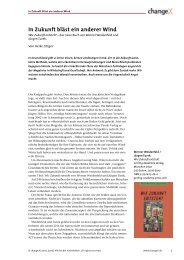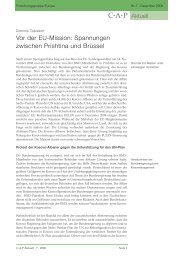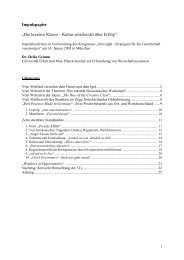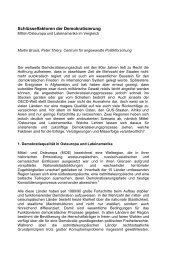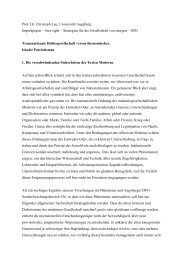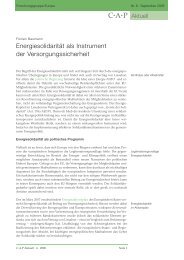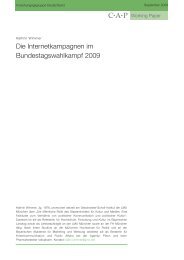Thesis paper concerning the Structured Dialogue from the ...
Thesis paper concerning the Structured Dialogue from the ...
Thesis paper concerning the Structured Dialogue from the ...
Create successful ePaper yourself
Turn your PDF publications into a flip-book with our unique Google optimized e-Paper software.
<strong>Thesis</strong> <strong>paper</strong> <strong>concerning</strong> <strong>the</strong> <strong>Structured</strong> <strong>Dialogue</strong><br />
<strong>from</strong> <strong>the</strong> perspective of <strong>the</strong> involved actors<br />
Summary of <strong>the</strong> Interim Evaluation Report 2012<br />
(1) The <strong>Structured</strong> <strong>Dialogue</strong> receives general approval <strong>from</strong> all involved actors. In<br />
contrast to <strong>the</strong> previous year, <strong>the</strong> classification of <strong>the</strong> respective projects in <strong>the</strong><br />
coherences of <strong>the</strong> <strong>Structured</strong> <strong>Dialogue</strong> and <strong>the</strong> EU‐Youth Strategy are known at<br />
least rudimentarily by most project leaders. But <strong>the</strong> European and federal<br />
implications of <strong>the</strong> projects are still less known by <strong>the</strong> decision‐makers and<br />
young people.<br />
(2) From <strong>the</strong> perspective of all involved actors, <strong>the</strong> <strong>Structured</strong> <strong>Dialogue</strong> imparts<br />
political relevance and new impetus <strong>from</strong> <strong>the</strong> EU for local youth participation,<br />
as well as it accomplishes a function of motivation and activation. Especially <strong>the</strong><br />
leaders of youth work consider <strong>the</strong> <strong>Structured</strong> <strong>Dialogue</strong> as a tail wind <strong>from</strong> <strong>the</strong><br />
EU and a support for <strong>the</strong>ir own work aiming at local youth participation.<br />
(3) The implementation of structured dialogue confronts topdown approaches<br />
with bottomup projects. A linked question for <strong>the</strong> youth organizations and<br />
project leaders is, how <strong>the</strong>y can combine this constructively and create added<br />
value.<br />
(4) It is important for <strong>the</strong> involved actors to implement <strong>the</strong> <strong>Structured</strong> <strong>Dialogue</strong> in<br />
municipal and local contexts in order to locate and link it with <strong>the</strong> living<br />
environment of young people. In doing so, <strong>the</strong>y use <strong>the</strong>ir own scopes of<br />
interpretation and action.<br />
(5) The project leaders recognize <strong>the</strong> European dimension as a core element of <strong>the</strong><br />
<strong>Structured</strong> <strong>Dialogue</strong>, whereby target groupspecific approaches to European<br />
issues are considered to play a central role. Implementing <strong>the</strong> EU‐Consultationtopics<br />
resp. national <strong>the</strong>me corridors has proven to be a difficult and complex<br />
challenge. Therefore, <strong>the</strong> topics are picked up and diversified depending on <strong>the</strong><br />
local needs and circumstances.<br />
(6) As project leaders suspect that due to its complexity, <strong>the</strong> <strong>Structured</strong> <strong>Dialogue</strong><br />
might ask too much <strong>from</strong> young people. Therefore <strong>the</strong>y are looking for starting<br />
points to link directly to young people’s living environments. For that task,<br />
project leaders see <strong>the</strong>mselves in an intermediary function.
(7) In addition to verbal reflection processes, medial and artistic means of<br />
expressions are important for young people in <strong>the</strong> different projects of <strong>the</strong><br />
<strong>Structured</strong> <strong>Dialogue</strong>. Particularly focusing on barely approachable young people,<br />
<strong>the</strong>se creative methods play a key function due <strong>the</strong> empowerment function <strong>the</strong>y<br />
offer.<br />
(8) The success of <strong>the</strong> dialogue processes depends on a setting ensuring a serious<br />
and respectful exchange at an eye level between <strong>the</strong> involved actors. To make<br />
this happen, young people and decision‐makers alike should be prepared<br />
specifically for <strong>the</strong> concrete dialogue situation.<br />
(9) <strong>Dialogue</strong> processes between young people and politics require time, endurance<br />
and continuity in order to develop gainfully. This is sometimes difficult for<br />
young people preferring a different speed of <strong>the</strong> regular political processes.<br />
Therefore leaders of youth work play an important role for <strong>the</strong> processes both as<br />
mediators and as carers.<br />
(10) In view of <strong>the</strong> financial, structural, and staffing requirements, <strong>the</strong> current<br />
austerity budgets for youth work will make it difficult in <strong>the</strong> long run to root <strong>the</strong><br />
<strong>Structured</strong> <strong>Dialogue</strong> on a sustainable basis and beyond single project funding.<br />
Eva Feldmann‐Wojtachnia / Dr Barbara Tham<br />
April 2013<br />
Center for Applied Policy Research (CAP)<br />
Research Group Youth & Europe<br />
at Ludwig Maximilians University Munich (LMU)<br />
Maria‐Theresia‐Str. 21<br />
(D) 81671 Munich (Germany)<br />
eva.feldmann@lrz.uni‐muenchen.de<br />
b.tham@lrz.uni‐muenchen.de



